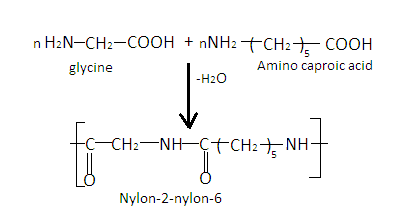
Answer
103.8k+ views
Hint: Biodegradable polymers are polymers which can be degraded or broken down by other living organisms like bacteria so that the polymer does not cause any serious effect on the environment.
Step by Step Explanation: Nylon-$2$ -nylon-$6$ is a biodegradable polymer. It is a polyamide and is obtained by condensation of monomers glycine $\left( {{{\text{H}}_2}{\text{N - C}}{{\text{H}}_2}{\text{ - COOH}}} \right)$ and amino caproic acid $\left[ {{{\text{H}}_2}{\text{N}}{{\left( {{\text{C}}{{\text{H}}_2}} \right)}_5}{\text{COOH}}} \right]$ . When n numbers of glycine are condensed with n numbers of amino caproic acid, Nylon-$2$ -nylon-$6$ is obtained with the loss of water molecules. The reaction is as follows:

Nylon-$2$ -nylon-$6$ is an alternating polyamide copolymer as it is prepared from two monomers. It is used in-
- Synthesis of artificial fibers.
- As a thread in the bristles of a toothbrush.
- In making strings of musical instruments.
- As matrix material.
- In car components next to the engine due to heat resistance property.
Hence the correct answer is B.
Additional Information: Besides Nylon-$2$ -nylon-$6$, dextran and PHBV which are both polyesters are also bio-degradable polymers which can be degraded by bacteria in the environment. The characteristics of biodegradable polymers are-
1. They are inert and non-toxic
2. They have bio-compatibility.
3. They have permeability.
4. They have tensile strength and mechanical strength.
5. They have controlled the rate of degradation as they can be easily degraded within a suitable time –period.
Note: Biodegradable polymers have many uses in medical field-
1. They are used as orthopedic devices
2. They are used as implants and sutures.
3. They are also used as rug-release matrices.
Step by Step Explanation: Nylon-$2$ -nylon-$6$ is a biodegradable polymer. It is a polyamide and is obtained by condensation of monomers glycine $\left( {{{\text{H}}_2}{\text{N - C}}{{\text{H}}_2}{\text{ - COOH}}} \right)$ and amino caproic acid $\left[ {{{\text{H}}_2}{\text{N}}{{\left( {{\text{C}}{{\text{H}}_2}} \right)}_5}{\text{COOH}}} \right]$ . When n numbers of glycine are condensed with n numbers of amino caproic acid, Nylon-$2$ -nylon-$6$ is obtained with the loss of water molecules. The reaction is as follows:

Nylon-$2$ -nylon-$6$ is an alternating polyamide copolymer as it is prepared from two monomers. It is used in-
- Synthesis of artificial fibers.
- As a thread in the bristles of a toothbrush.
- In making strings of musical instruments.
- As matrix material.
- In car components next to the engine due to heat resistance property.
Hence the correct answer is B.
Additional Information: Besides Nylon-$2$ -nylon-$6$, dextran and PHBV which are both polyesters are also bio-degradable polymers which can be degraded by bacteria in the environment. The characteristics of biodegradable polymers are-
1. They are inert and non-toxic
2. They have bio-compatibility.
3. They have permeability.
4. They have tensile strength and mechanical strength.
5. They have controlled the rate of degradation as they can be easily degraded within a suitable time –period.
Note: Biodegradable polymers have many uses in medical field-
1. They are used as orthopedic devices
2. They are used as implants and sutures.
3. They are also used as rug-release matrices.
Recently Updated Pages
Write a composition in approximately 450 500 words class 10 english JEE_Main

Arrange the sentences P Q R between S1 and S5 such class 10 english JEE_Main

Write an article on the need and importance of sports class 10 english JEE_Main

Name the scale on which the destructive energy of an class 11 physics JEE_Main

Choose the exact meaning of the given idiomphrase The class 9 english JEE_Main

Choose the one which best expresses the meaning of class 9 english JEE_Main

Other Pages
A physical quantity which has a direction A Must be class 11 physics JEE_Main

Electric field due to uniformly charged sphere class 12 physics JEE_Main

Formula for number of images formed by two plane mirrors class 12 physics JEE_Main

For pure water A pH increases while pOH decreases with class 11 chemistry JEE_Main

If a wire of resistance R is stretched to double of class 12 physics JEE_Main




